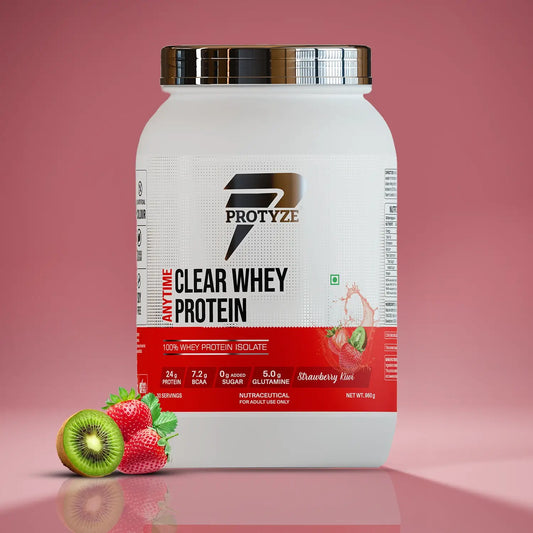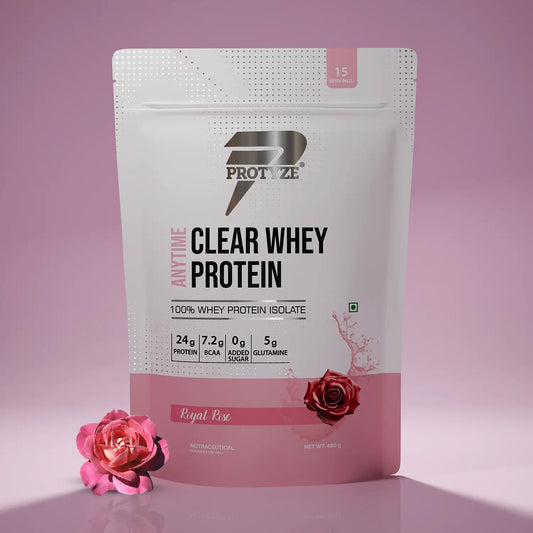A strong core is the secret weapon of a healthy, powerful body. It’s not just about carving out a six-pack for the mirror—core strength is the backbone of every movement you make, whether you’re squatting heavy weights, running a 5K, or simply carrying groceries. It boosts your posture, enhances stability, and protects you from injuries that creep up when your midsection is weak.
No matter your fitness level—beginner, intermediate, or pro—the right core exercises can transform how you feel and perform. In this article, we’ll walk you through the best core strength exercises to strengthen your abs and improve stability, step by step. Plus, we’ll explore how nutrition, like Protyze CLEAR Whey Protein, can fuel your progress. Buckle up—this is a deep dive into building a rock-solid core!
Why Core Strength Is a Big Deal
Before we jump into the exercises, let’s unpack why your core matters so much. Your core isn’t just those front-facing abs (the rectus abdominis) you see in fitness ads. It’s a whole squad of muscles working together: the obliques on your sides, the transverse abdominis deep inside, and even your lower back, hips, and pelvic floor. These muscles team up to hold your spine steady, transfer power from your legs to your arms, and keep you balanced whether you’re standing still or leaping into action.
A weak core? That’s a recipe for trouble. You might slouch through your day, feel twinges in your back, or wobble during workouts. On the flip side, a strong core means smoother lifts, better runs, and less chance of pulling something. It’s not about vanity—it’s about function. And yes, a tighter midsection comes as a bonus. So, how do you build this powerhouse? Let’s break down the best exercises to get you there.
1. Plank

What It Is
The plank is the king of core exercises—simple, no gear needed, and brutally effective. You hold a push-up-like position, resting on your forearms or hands, keeping your body in a straight line from head to heels.
How to Do It
- Start face-down on the floor, elbows bent at 90 degrees directly under your shoulders, forearms flat.
- Push up onto your toes and forearms (or hands for a high plank), lifting your body off the ground.
- Tighten your abs, glutes, and legs—your body should look like a plank of wood, no sagging hips or arched back.
- Hold steady for 20-60 seconds (start small if you’re new), breathing deeply and evenly.
Why It Works
Planks are a full-core workout. They fire up your rectus abdominis for that front strength, your obliques for side stability, and your transverse abdominis for deep support. Plus, they build endurance and teach your body to stay rigid under pressure—key for stability in sports or daily life.
Benefits
- Strengthens every core muscle at once.
- Improves posture by training spinal alignment.
- Boosts balance for other exercises.
Common Mistakes
- Letting your hips dip (strains your back).
- Sticking your butt up (reduces core work).
- Holding your breath (makes it harder).
Pro Tip
Mix it up: try a side plank to hit your obliques harder. Stack your feet, rest on one forearm, and hold for 20-30 seconds per side. Feel the burn!
2. Dead Bug

What It Is
The dead bug sounds funny, but it’s a beginner-friendly gem. You lie on your back, moving your arms and legs like a flipped-over insect, all while keeping your core locked tight.
How to Do It
- Lie flat on your back, arms straight up toward the ceiling, knees bent at 90 degrees so shins are parallel to the floor.
- Press your lower back into the ground—there should be no gap.
- Slowly extend your right arm overhead and your left leg out straight, hovering an inch above the floor.
- Return to the starting position, then switch—left arm and right leg. Aim for 10-12 reps per side.
Why It Works
Dead bugs zero in on your transverse abdominis, the deep core muscle that wraps around your midsection like a corset. It teaches control—moving your limbs without letting your spine wiggle—which is gold for stability.
Benefits
- Builds deep core strength safely.
- Improves coordination for complex moves.
- Protects your lower back from strain.
Common Mistakes
- Arching your back (loses the core focus).
- Moving too fast (sacrifices control).
- Lifting your head (strains your neck).
Pro Tip
Go slow—think 2-3 seconds per extension. If your back lifts off the floor, shorten the range until you’re stronger.
3. Russian Twists

What It Is
Russian twists are a seated, twisting move that carve your obliques and power up your ability to rotate—think swinging a bat or turning to grab something.
How to Do It
- Sit on the floor, knees bent, feet flat (or lifted off the ground for extra challenge).
- Lean back slightly—about 45 degrees—keeping your spine straight, not rounded.
- Hold a weight (dumbbell, water bottle, or even your hands clasped together).
- Twist your torso to the left, bringing the weight beside your hip, then twist right. Do 15-20 twists total.
Why It Works
This move targets your obliques, the side muscles that help you bend and twist. It also strengthens rotational stability, which you need for sports or everyday tasks like reaching across your body.
Benefits
- Sculpts your waistline.
- Boosts rotational power.
- Engages your whole core for balance.
Common Mistakes
- Hunching your back (hurts your spine).
- Using momentum (cheats your muscles).
- Twisting too far (strains your back).
Pro Tip
Keep your chest lifted and eyes forward—don’t let your shoulders slump. Add weight gradually as you get stronger.
4. Bicycle Crunches

What It Is
Bicycle crunches are a dynamic twist on regular crunches. You lie down, pedaling your legs while touching opposite elbows to knees.
How to Do It
- Lie on your back, hands lightly behind your head (don’t pull your neck).
- Lift your legs off the ground, knees bent at 90 degrees.
- Bring your right elbow toward your left knee while straightening your right leg out.
- Switch sides in a smooth, pedaling motion—left elbow to right knee. Aim for 15-20 reps per side.
Why It Works
This move hits your rectus abdominis (front abs) and obliques together, building strength and coordination. The pedaling action also mimics real-world movements, making it functional.
Benefits
- Targets multiple core areas.
- Increases endurance and control.
- Burns calories with constant motion.
Common Mistakes
- Yanking your neck (causes pain).
- Rushing through (reduces effectiveness).
- Letting legs drop (eases core tension).
Pro Tip
Slow it down—take 1-2 seconds per twist. Focus on crunching your abs, not just swinging your elbows.
5. Hanging Leg Raises

What It Is
Hanging leg raises are an advanced move where you hang from a pull-up bar and lift your legs, zeroing in on your lower abs.
How to Do It
- Grab a pull-up bar with an overhand grip, arms straight, body relaxed.
- Keep your legs together and lift them up to hip height (or higher if you’re strong).
- Lower them back down slowly—no swinging or kicking. Shoot for 10-15 reps.
Why It Works
This exercise blasts your lower abs, a tricky spot to hit, while testing your core’s ability to stabilize your body mid-air. It’s a powerhouse for strength and control.
Benefits
- Defines lower abs.
- Builds grip and core endurance.
- Supports heavy lifts with stability.
Common Mistakes
- Swinging your body (cheats the abs).
- Bending at the hips too much (lessens focus).
- Dropping legs fast (loses control).
Pro Tip
If straight legs are tough, bend your knees and lift to chest height. Focus on slow descents for max tension.
6. Bird Dog

What It Is
The bird dog is a stability exercise done on all fours, extending opposite arm and leg to challenge your balance and core.
How to Do It
- Get on hands and knees, hands under shoulders, knees under hips, back flat.
- Extend your right arm straight forward and left leg straight back, keeping your hips square.
- Hold for 3-5 seconds, then switch sides—left arm, right leg. Do 10 reps per side.
Why It Works
Bird dogs strengthen your deep core and lower back, syncing your muscles for better balance. It’s gentle but builds a solid foundation.
Benefits
- Enhances spinal stability.
- Strengthens back and abs together.
- Improves coordination and posture.
Common Mistakes
- Lifting hips too high (reduces core work).
- Twisting your body (loses balance).
- Rushing the hold (misses the point).
Pro Tip
Imagine balancing a glass of water on your back—stay level and steady. Extend fully for the full effect.
Building Core Strength: The How-To Guide
Now that you’ve got the moves, let’s make them work for you. Here’s how to build a strong, stable core step by step.
1. Start Where You Are
Newbies should begin with planks and dead bugs—focus on form over time. Hold a plank for 20 seconds or do 8 dead bug reps per side. Master these before moving up.
2. Progress Gradually
As you get stronger, increase duration (plank for 60 seconds) or reps (15 bicycle crunches per side). Add weight to Russian twists or try hanging leg raises when ready.
3. Mix and Match
Hit all core angles: planks for endurance, twists for rotation, raises for lower abs, bird dogs for back stability. A 10-15 minute circuit 3-4 times a week is plenty.
4. Perfect Your Form
Quality beats quantity. Keep your spine neutral—no sagging or arching—and move with control. Sloppy form wastes effort and risks injury.
5. Breathe Properly
Exhale on the hard part (lifting legs in raises) and inhale on the easy part (lowering). This keeps your core engaged and oxygen flowing.
6. Rest and Recover
Muscles grow during rest, not just work. Give your core a day off between intense sessions—active recovery like walking is fine.
Fueling Your Core with Nutrition
Exercise builds your core, but nutrition makes it stick. Protein is the MVP here—it repairs tiny muscle tears from planks or twists, helping them grow stronger. Aim for 1.6-2.2g of protein per kg of body weight daily. Whole foods like chicken, eggs, and lentils are great, but supplements can fill gaps.
Protyze CLEAR Whey Isolate is a perfect match—light, clean, and packed with protein:
- Post-Workout Recovery: Protyze Nitro Clear Whey (30g protein + creatine + glutamine) rebuilds after tough sessions.
- Daily Protein Boost: Protyze Anytime Clear Whey (24g) keeps you fueled without heaviness.
- Lean Goals: Protyze Diet Clear Whey (15g + probiotics) supports abs while cutting fat.
Unlike thick, milky shakes, it’s water-based and 99% lactose-free—no bloating, just results. Pair it with carbs (like oats) and fats (like nuts) for a balanced diet that powers your core work.
Core Strength in Real Life
A strong core isn’t just for Instagram pics—it’s a game-changer. It steadies your deadlifts, speeds your sprints, and saves your back when you lift a heavy box. Good posture from planks cuts desk-job slouch. Stability from bird dogs keeps you steady on uneven ground. These exercises don’t just sculpt—they make you move better, from the gym to the grocery store.
Common Core Myths to Bust
Myth 1: Crunches Are Enough
Crunches hit your front abs, but neglect obliques, deep core, and back. Mix in planks and twists for the full picture.
Myth 2: More Reps = Better Abs
Endless reps tire you out without building strength. Focus on form and controlled sets—quality over quantity.
Myth 3: Core Work Slims Your Waist
Exercise tones muscle, but fat loss comes from diet and cardio. Pair core moves with nutrition—like Protyze Diet Clear Whey—to reveal those abs.
Conclusion
Your core is your body’s anchor—strengthen it, and everything else falls into place. Planks, dead bugs, Russian twists, bicycle crunches, hanging leg raises, and bird dogs are the best exercises to build abs and stability. Start simple, stay consistent, and fuel up with protein like Protyze CLEAR Whey Isolate—light, effective, and tailored to your goals. This isn’t just about looks—it’s about power, balance, and a body that’s ready for anything. Get started today, and feel the strength grow from the inside out!
FAQs (Frequently Asked Questions)
1. What’s the best core exercise for beginners?
The plank and dead bug are perfect for beginners. Planks are simple—just hold your body straight on your forearms or hands for 20-30 seconds. Dead bugs involve lying on your back and moving your arms and legs slowly while keeping your core tight. Both build strength without overwhelming you, and they focus on form to avoid injury.
2. How often should I do core exercises?
Aim for 3-4 times a week, with sessions lasting 10-15 minutes. Your core needs work to grow strong, but it also needs rest to recover—don’t overdo it daily. Mix moves like planks, Russian twists, and bird dogs for a balanced routine, and take a day off between intense days.
3. Can core exercises get rid of belly fat?
Not directly—core exercises strengthen and tone your muscles, but fat loss comes from diet and cardio. Moves like bicycle crunches or hanging leg raises build abs, but to see them, pair your workouts with healthy eating. A protein boost like Protyze Diet Clear Whey (15g protein + probiotics) can support fat loss while keeping your muscles strong.
4. Do I need equipment for core strength exercises?
Nope! Most of these—like planks, dead bugs, and bicycle crunches—use just your body weight. For Russian twists, you can hold a water bottle or skip the weight entirely. Hanging leg raises need a pull-up bar, but that’s optional—start with what you’ve got at home.
5. Why do I feel my back during core exercises?
If your back hurts, your form might be off. Sagging hips in planks or arching your back in dead bugs shifts the strain from your abs to your spine. Focus on keeping your lower back flat and core tight. Start with easier moves like bird dogs to build control and avoid overdoing it.
TL;DR
Build a strong core with top exercises: planks for full-core endurance, dead bugs for deep stability, Russian twists for oblique power, bicycle crunches for abs and coordination, hanging leg raises for lower abs, and bird dogs for balance. Do them 3-4 times a week, 10-15 minutes, focusing on form. Pair with protein—like Protyze Nitro Clear Whey post-workout—to boost recovery. Strengthen your abs, improve stability, and move better!





